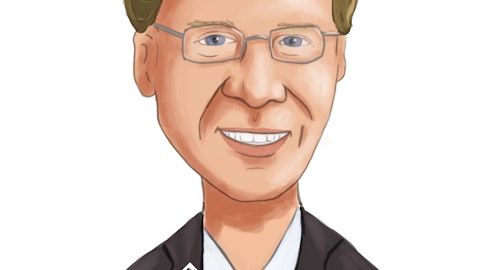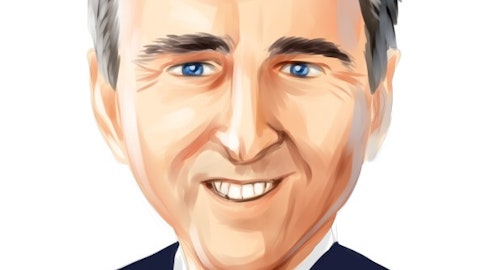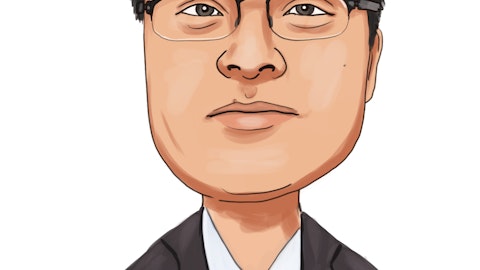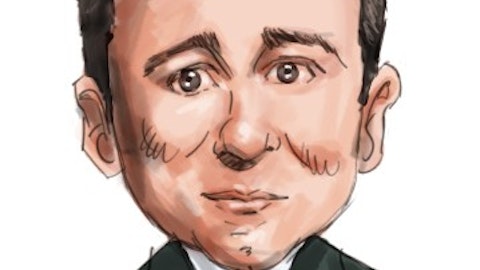Daniel Tamayo: Do you have a sense of how much compression that might be, I mean, assuming you are your 25 basis point — 25% cumulative deposit beta, how much do you think the margin could potentially contract from the peak in the first quarter?
Jim Reske: Well, based on what we know now, we see continuing — the peak is in the first one, the peak is in the second quarter, so we will continue to expand active in the second quarter. But then where we see it ending the year is still over 4%, so not giving back on the expansion. So I am a little higher than we are now. And I hasn’t to go that far out, because I think the marks on Centric as we calculate the final marks are going to affect this number, and of course, deposit costs and how we manage that, of course. Probably, over the course of the year, this could change. So we will have to update this as we go ahead. But as we see it right now, we see that number staying above 4% by the end of the year.
Daniel Tamayo: All right. Terrific. That’s very helpful. I appreciate it. I know it’s a tough number to get at especially with the marks. So I appreciate you answering the questions.
Mike Price: Yeah. Thank you, Dan.
Operator: Our next question comes from Frank Schiraldi with Piper Sandler.
Frank Schiraldi: Hey, guys.
Mike Price: Good afternoon.
Frank Schiraldi: Just on the thinking about the efficiency ratio in the quarter right at 50% and the positive operating leverage for 2023 and the cost base in Centric. So given that you imply obviously a sub-50% efficiency ratio, is that a place you think, as you think about more medium-term maybe that you think you can operate the bank from or I understand an offset will be the Durbin impact in mid-2024? Just wondering your thoughts on kind of longer term where you think you can operate the bank from in terms of efficiencies?
Mike Price: I think you used the term midterm, which to me would apply one year or two years. And I think low 50s we are comfortable with because we plan to grow the bank. You have seen us kind of methodically put together a lot of diversified revenue engines and we are going to continue to ramp those up. So we will — we would like to continue to grow the bank that we have — the way we have in the last two years and make investments. And of course, we have new territory in Central Pennsylvania and in the outskirts of the Philadelphia MSA. And so I think I don’t see us doing sub-50 right away and we want to build out the revenue side of the bank and grow the bank.
Frank Schiraldi: Okay. And then you — a lot of talk about the NIM and I am hesitant to ask because, Jim, you said you were hesitant to go out to the end of next year. But as you think about if the Fed, we get a couple of more rate hikes here and then the Fed is the interest rate picture is a little more static for some time. Do you feel like that NIM above 4% is an area where the bank could see — could operate at, maybe it plateaus there? Are you thinking that in 2024, it’s more likely that the NIM continues to drop to a more normalized level? I guess that’s what I am trying to search out if you think in a static rate environment a normalized level could be above that 4% figure.
Jim Reske: Yeah. It’s a tough question. My — to use an old joke, my crystal ball gets cloudy when we start getting out to 2024, but we have actually stressed it for the kind of scenario you are talking about, because we realize that — we using consistently the rate forecast we are using with this. Our approach that as the way, we do our CECL model with it, 40% laid on the baseline, 30% upside downside, using that rate forecast that they might be under overstated. So we try to stress it, and say, well, what happens if it’s wrong, what happens if rates — the Fed raises rates a little more aggressively here and rates stay up for a while longer. And I can tell you the answer generally for us is that it’s better. The NIM is better.
So the margin is better and it stays higher for longer, but the pattern is pretty much the same. You get to a peak and then it comes down. Now in that world, I would tell you that, we end up pretty based what I know now. You have a margin that ends the year well above 4%. What it goes to in 2024, I actually don’t have that, but my guess would be that it would drift downward and continue downward if deposit costs play out, because if deposits — if rates go to 5%, stay there for two years or three years to sell it, eventually deposit rates are going to keep going up and up and up.
Frank Schiraldi: Got it. Okay. And then just lastly, kind of I was surprised that the consumer continues to be as strong as it has been in terms of the as a driver — as a partial driver of loan growth. Sorry if I missed it in your prepared remarks, but are you starting to see a slow down or are you expecting a slowdown on that side of things, just given the macro environment with more of a pickup in commercial going forward into 2023?
Mike Price: We are. I mean, we did — we might do 10% less in mortgage this next year, but not 20% or 30%. I mean if we were at 4.70, we might be at 4.30 in first mortgage. HELOC, HELOAN is probably much softer and under pressure, but also we think in our good people in the branches and we have really got to focus on deposits and calling on business customers, small business customers. The indirect auto business looks good and the team has done a nice job of getting our spreads up in that business. It’s very well managed. And so that’s a business that can probably help us, but we will be doing some HELOC and HELOAN out of branches, and we will be doing some mortgage and not a lot less actually from maybe the high 4s to maybe the mid or low 4s.
And but that’s also a business that, long-term we like the business, because we get a cornerstone checking account that we cross sell. We get households, a customer for life and so I think the consumer business is something that is important to us. Jane, anything you would add?
Jane Grebenc: Not really, Mike. I think you covered it. We think the consumer is healthy.
Frank Schiraldi: Okay. Great. I appreciate the color. Thank you.





